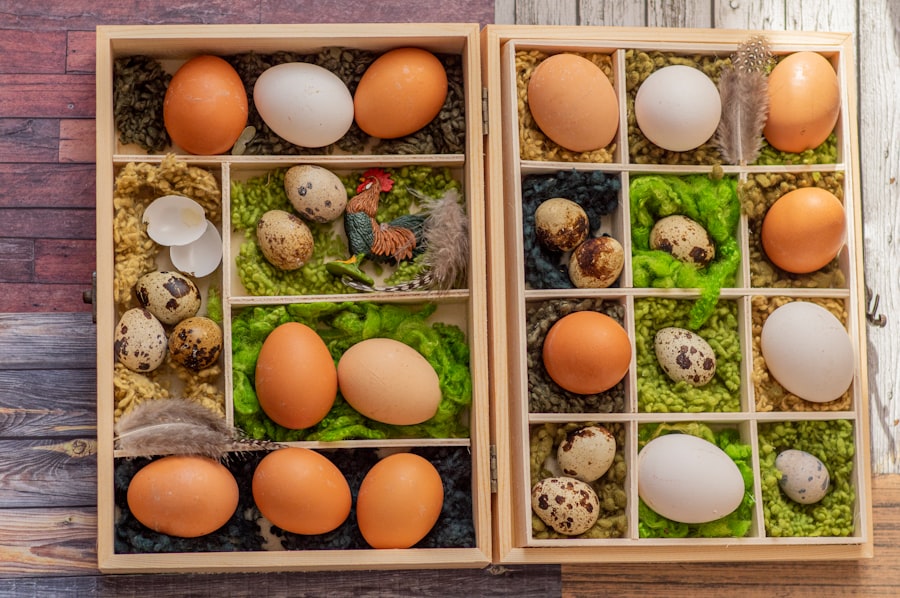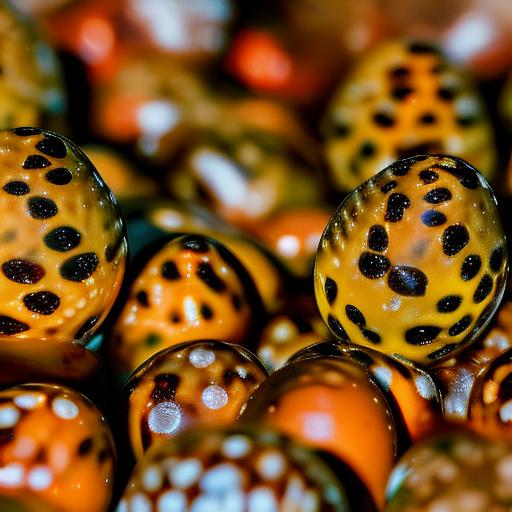Quail eggs are small, speckled eggs that come from the quail bird, a small game bird that is native to Europe, Asia, and Africa. These eggs are gaining popularity in the culinary world due to their delicate flavor and high nutritional value. Quail eggs are packed with essential nutrients such as protein, vitamins, and minerals, making them a healthy addition to any diet. They are also known for their beautiful appearance, with a unique speckled pattern on their shells that adds an elegant touch to any dish. Quail eggs are commonly used in a variety of dishes, including salads, appetizers, and even as a garnish for main courses. They are also a popular choice for pickling and preserving due to their small size and delicate flavor. In addition to their culinary uses, quail eggs are also sought after for their potential health benefits, as they are believed to have antioxidant properties and may help improve immune function.
Quail eggs are also used in the agricultural industry for hatching quail chicks. Due to their small size, quail eggs require specific care and attention when it comes to storage and incubation. The shelf life of quail eggs is relatively short compared to chicken eggs, and they require specific conditions to remain viable for hatching. In the following sections, we will explore the shelf life of quail eggs, how to store them before incubation, signs of spoilage to look out for, factors affecting their viability, and tips for successful incubation.
Key Takeaways
- Quail eggs are smaller than chicken eggs and have a delicate flavor, making them a popular choice for cooking and snacking.
- Quail eggs have a shorter shelf life compared to chicken eggs, typically lasting for about 3-4 weeks when properly stored.
- Before incubating, quail eggs should be stored in a cool, humid environment with the pointed end facing downwards to maintain their viability.
- Signs of spoilage in quail eggs include a foul odor, cracked or leaking shells, and discoloration of the egg white or yolk.
- Factors affecting the viability of quail eggs include age, handling, and storage conditions, so it’s important to carefully select and store eggs for successful incubation.
The Shelf Life of Quail Eggs
Quail eggs have a shorter shelf life compared to chicken eggs due to their higher yolk to white ratio and thinner shells. On average, quail eggs can be stored for up to 5-7 days at room temperature before they start to lose viability. However, if you plan to incubate the eggs, it is best to use them within 2-3 days of being laid to ensure the highest hatch rate. If you need to store quail eggs for a longer period of time before incubation, it is best to refrigerate them at a temperature of around 45-50°F (7-10°C). Refrigeration can extend the shelf life of quail eggs by an additional 2-3 weeks, but it is important to note that the longer the eggs are stored, the lower the hatch rate may be.
To further extend the shelf life of quail eggs, some people choose to coat the eggs with a thin layer of mineral oil. This can help seal the pores in the eggshell and reduce moisture loss, which can prolong the viability of the eggs. However, it is important to use food-grade mineral oil and apply it carefully to avoid contaminating the eggs. Overall, it is best to use quail eggs as soon as possible for the highest hatch rate and best results.
Storing Quail Eggs Before Incubating
Before incubating quail eggs, it is crucial to store them properly to ensure their viability. When collecting quail eggs for incubation, it is important to handle them with care to avoid any damage to the delicate shells. It is best to collect the eggs at least twice a day to prevent them from sitting in the nest for too long, which can decrease their viability. Once collected, the eggs should be stored in a clean and dry environment at a temperature of around 50-60°F (10-15°C). It is important to store the eggs with the pointed end facing downwards, as this helps keep the air cell in the correct position and prevents the embryo from sticking to the shell membrane.
If you need to store quail eggs for a short period of time before incubation, you can place them in an egg carton with the pointed end facing downwards and store them in a cool, dark place. However, if you plan to store the eggs for a longer period of time, it is best to refrigerate them as mentioned earlier. It is important to avoid sudden temperature changes when storing quail eggs, as this can cause condensation to form on the eggshell, which can lead to bacterial contamination and decreased viability. By following these storage guidelines, you can help ensure that your quail eggs remain viable for incubation.
Signs of Spoilage in Quail Eggs
It is important to be able to identify signs of spoilage in quail eggs before attempting to incubate them. Spoiled eggs can negatively impact hatch rates and may even lead to the spread of bacteria in an incubator. One common sign of spoilage in quail eggs is an off-putting odor when the egg is cracked open. Fresh quail eggs should have a neutral or slightly earthy smell, while spoiled eggs may have a foul or sulfur-like odor. Additionally, spoiled quail eggs may have discolored or cloudy egg whites, as well as irregular or enlarged air cells.
Another indicator of spoilage in quail eggs is the presence of mold or bacteria on the eggshell. Mold can appear as fuzzy spots on the shell or as discoloration, while bacteria may cause slimy or sticky residue on the eggshell. It is important to carefully inspect each egg before placing it in an incubator and discard any eggs that show signs of spoilage. By being vigilant about identifying spoiled quail eggs, you can help ensure a higher hatch rate and reduce the risk of contamination in your incubator.
Factors Affecting the Viability of Quail Eggs
Several factors can affect the viability of quail eggs during storage and incubation. One of the most critical factors is temperature fluctuations, as sudden changes in temperature can cause condensation to form on the eggshell, leading to bacterial contamination and decreased viability. It is important to store quail eggs at a consistent temperature and avoid exposing them to extreme heat or cold.
The age of the quail eggs also plays a significant role in their viability. As mentioned earlier, quail eggs have a relatively short shelf life compared to chicken eggs, and their hatch rate decreases as they age. It is best to use quail eggs for incubation within 2-3 days of being laid for the highest hatch rate. Additionally, the condition of the eggs at the time of collection can impact their viability. Eggs that are cracked, dirty, or mishandled are less likely to hatch successfully and should be discarded.
The humidity levels in the storage environment can also affect the viability of quail eggs. High humidity can lead to moisture loss and decreased hatch rates, while low humidity can cause shrinkage of the air cell and lead to difficulty hatching. It is important to store quail eggs in a clean and dry environment with moderate humidity levels to ensure their viability.
Tips for Successful Incubation of Quail Eggs

Successfully incubating quail eggs requires careful attention to detail and specific environmental conditions. One crucial factor for successful incubation is maintaining consistent temperature and humidity levels throughout the entire process. The ideal temperature for incubating quail eggs is around 99.5°F (37.5°C), with a relative humidity of 45-50% for the first 14 days and 65-70% for the final 3 days before hatching.
It is also important to regularly turn the quail eggs during incubation to prevent the embryo from sticking to the shell membrane and promote even development. Quail eggs should be turned at least 3-5 times per day until day 14 of incubation when they should be placed in a stationary position for hatching.
Proper ventilation is essential during incubation to ensure an adequate supply of oxygen for the developing embryos. It is important to provide ventilation holes in the incubator or periodically open the vents to allow fresh air exchange while preventing carbon dioxide buildup.
Lastly, it is crucial to monitor the development of the embryos throughout the incubation period by candling the eggs. Candling involves shining a bright light through the eggshell to observe the development of the embryo and detect any potential issues such as infertility or early mortality.
By following these tips for successful incubation of quail eggs, you can increase your chances of achieving a high hatch rate and successfully hatching healthy quail chicks.
Conclusion and Final Thoughts
In conclusion, quail eggs are prized for their delicate flavor, high nutritional value, and potential health benefits. Whether used in culinary applications or for hatching quail chicks, proper storage and handling of quail eggs are essential for maintaining their viability. By understanding the shelf life of quail eggs, how to store them before incubation, signs of spoilage, factors affecting their viability, and tips for successful incubation, you can maximize your chances of achieving successful hatching results.
It is important to handle quail eggs with care, store them in a clean and dry environment at consistent temperatures, and regularly monitor their condition throughout storage and incubation. By following these guidelines and best practices, you can increase your chances of successfully hatching healthy quail chicks from your quail eggs.
Whether you are a culinary enthusiast looking to incorporate quail eggs into your recipes or an aspiring quail breeder looking to hatch your own chicks, understanding how to properly handle and store quail eggs is essential for achieving optimal results. With proper care and attention, you can enjoy the unique flavor and nutritional benefits of quail eggs or successfully hatch a new generation of quails with confidence.
If you’re wondering how long you can keep quail eggs before incubating, it’s important to understand the proper storage methods. In a related article on PoultryWizard, they discuss the benefits of using a chicken coop trampoline to keep your flock entertained and active. This innovative idea not only provides exercise for your chickens but also helps in maintaining a healthy and happy coop environment. To learn more about this unique approach, check out the article here.
FAQs
How long can quail eggs be stored before incubating?
Quail eggs can be stored for up to 7-10 days before incubating. It is important to store them properly in a cool, dry place with consistent temperature.
What is the best way to store quail eggs before incubating?
The best way to store quail eggs before incubating is to keep them in a clean and dry egg carton, with the pointed end facing downwards. Store them in a cool place with a consistent temperature, ideally around 55-60°F (13-16°C).
Can quail eggs be refrigerated before incubating?
It is not recommended to refrigerate quail eggs before incubating, as the fluctuating temperatures in a refrigerator can negatively impact the viability of the eggs. It is best to store them at a consistent cool temperature outside of the refrigerator.
How can I tell if quail eggs are still viable for incubation?
To check if quail eggs are still viable for incubation, you can perform a process called “candling.” This involves shining a bright light through the egg to see if there are any signs of development, such as veins or a developing embryo. Eggs that are clear or have a blood ring are not viable and should not be incubated.
What should I do if I cannot incubate the quail eggs within the recommended time frame?
If you are unable to incubate the quail eggs within the recommended time frame, you can consider extending the storage time by a few days, but the hatch rate may decrease. It is best to try to find a way to incubate the eggs within the recommended time frame for the best results.
Meet Walter, the feathered-friend fanatic of Florida! Nestled in the sunshine state, Walter struts through life with his feathered companions, clucking his way to happiness. With a coop that’s fancier than a five-star hotel, he’s the Don Juan of the chicken world. When he’s not teaching his hens to do the cha-cha, you’ll find him in a heated debate with his prized rooster, Sir Clucks-a-Lot. Walter’s poultry passion is no yolk; he’s the sunny-side-up guy you never knew you needed in your flock of friends!







